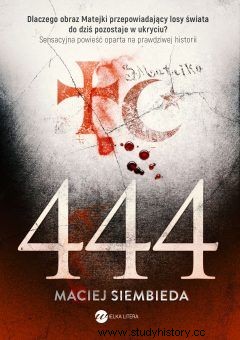Why is Matejko's painting predicting the fate of the world still not exhibited? Sensational novel "444" by Maciej Siembieda, based on real events, tells the story of "The Baptism of Władysław Warneńczyk" hidden deep in the basement of the National Museum in Warsaw.
A journalist from one of the popular newspapers dies in a car accident. His car is crushed by a speeding truck with Albanian registrations. Brakes failed. The truck driver will probably serve several years for manslaughter. What if this death was not accidental?
Prosecutor Jakub Kania from the Institute of National Remembrance will confront her mystery in Maciej Siembieda's novel. However, it will not be a duel for paragraphs. Neither will Kania be opposed to the Islamic State, secret government agencies, or even the communist past. The mystery he will have to explore goes back millennia and concerns a secret prophecy that an unknown hand has embroidered on a scrap of fabric. It is guarded by the secret brotherhood of Bakira, which will not hesitate to do anything in the service of the Prophet Muhammad.
So what does the accident from Warsaw's Wola district have to do with the Arab fairy tale about the liar's moon and the silent princess imprisoned for centuries in a Lusitan castle? Can the breaking of the truce in Szeged and the death of Władysław Warneńczyk be connected with the illegitimate son of Alexander I Romanov, and is it because of him the "Baptism of Władysław Warneńczyk on 18II.1425" Jan Matejko is the most frequently stolen Polish painting? This, in a nutshell, is the plot of this great novel.
Now for the facts. In the basement of the National Museum in Warsaw there is the "Baptism of Varna", a painting painted by Jan Matejko in 1881. The history of the painting begins in Volhynia, on the property of the Głębocki family, who have gathered there a large collection of valuable works of art. Along with the paintings of Malczewski and Wyczółkowski, on the walls of the family estate there was also the "Baptism of Varna". The painting was a pride of the Głębockie's living room until 1916. His later fate is quite mysterious. The family's collection survived World War I almost intact. Almost, because the "Baptism of Varna" disappeared from the collection.

The painting "The Baptism of Władysław Warneńczyk" by Matejko is often omitted in literature. Maciej Siembieda returns to work in his novel "444".
Just before World War II, the painting appeared at an exhibition in Warsaw's Zachęta Gallery, where it was seen by Andrzej Głębocki, who initiated efforts to return the work of art. This is how the investigation, which has not been completed to this day, began. The investigation led to Stieglitz, an art dealer from Krakow, who purchased a canvas from a Prague merchant for considerable money.
During the occupation, the valuable collections of a Jewish antiquarian interested Peter Menten, a Dutch entrepreneur and art collector, a war criminal, who murdered Jews with the same passion as he plundered fortunes. The Nazi Menten and the Jew Stieglitz formed a peculiar duo. The former promised the latter a safe trip to Tel Aviv, the latter was to provide information and works of art in return.
Final:The Main Commission for the Investigation of Nazi Crimes in Poland decided that Matejko's painting was in the hands of Menten and most likely burned down in his estate near Amsterdam. The Głęboccy never believed the explanation they received, hoping that the canvas would still be found. And they were right. The painting mysteriously appeared in the collection of the National Museum in Warsaw, but is not exhibited. The story is mysterious, but documented, although for some reason experts of Matejko's work not commented on and only briefly described.
Buy the book at a discount on empik.com:

